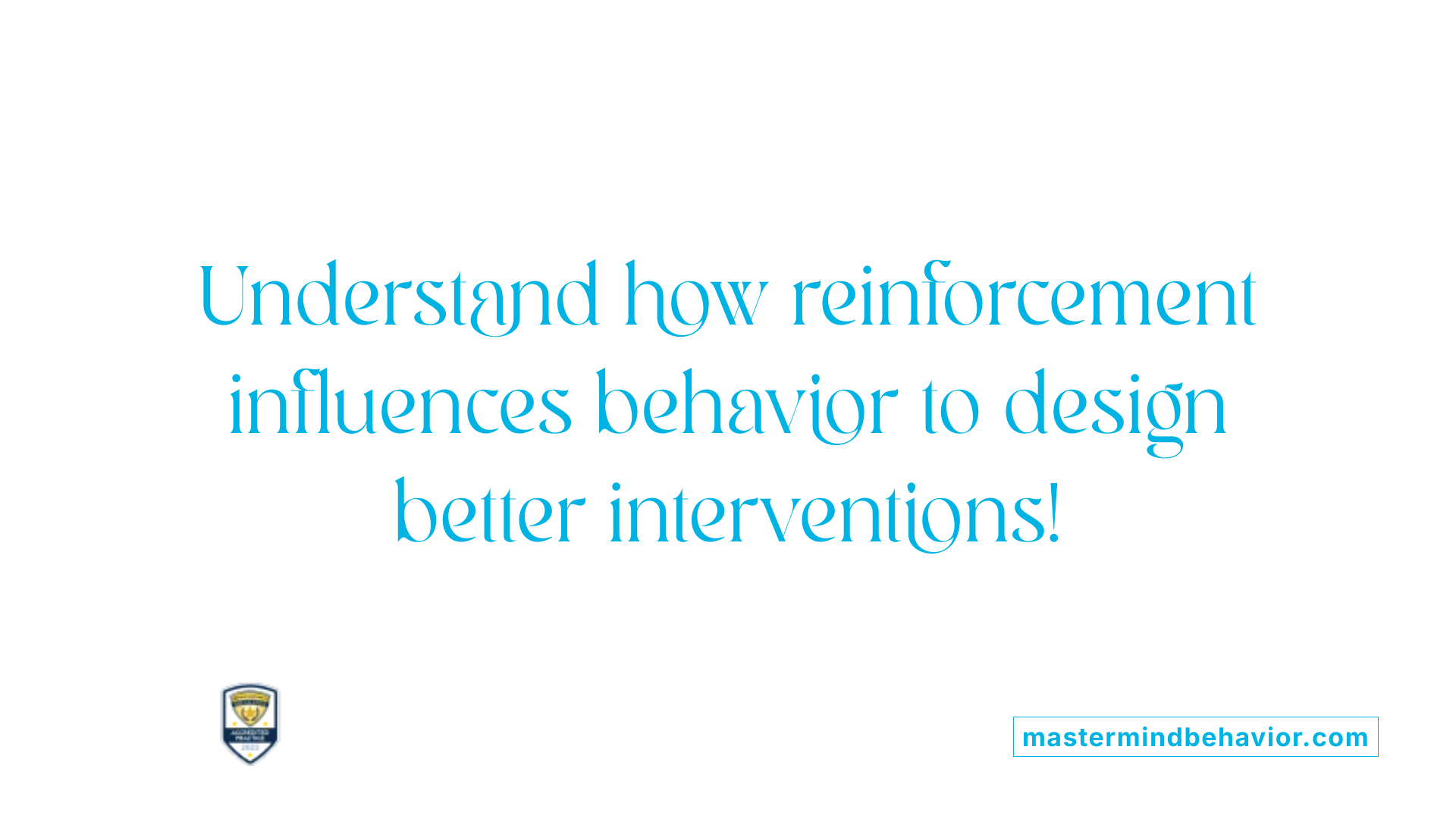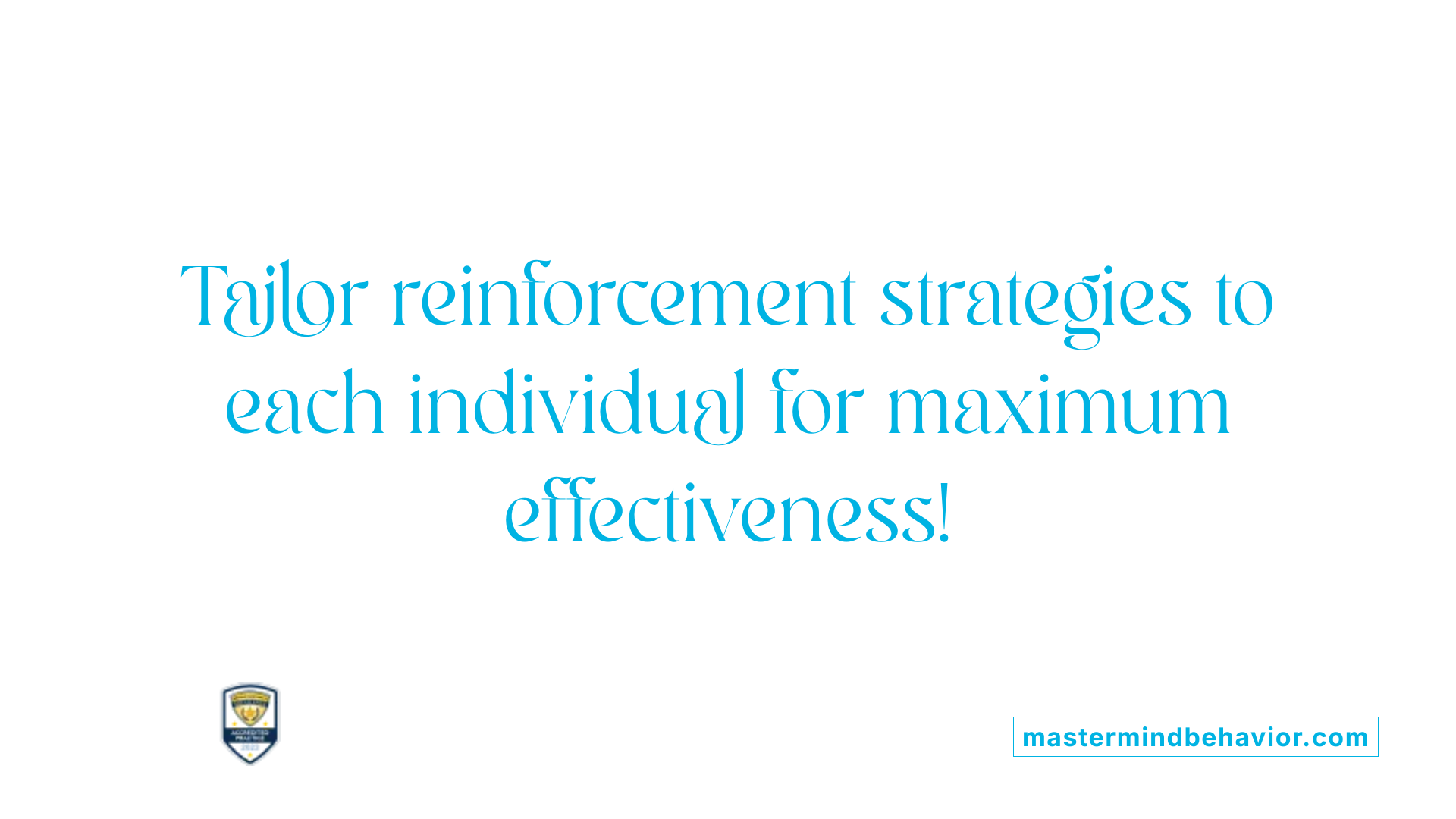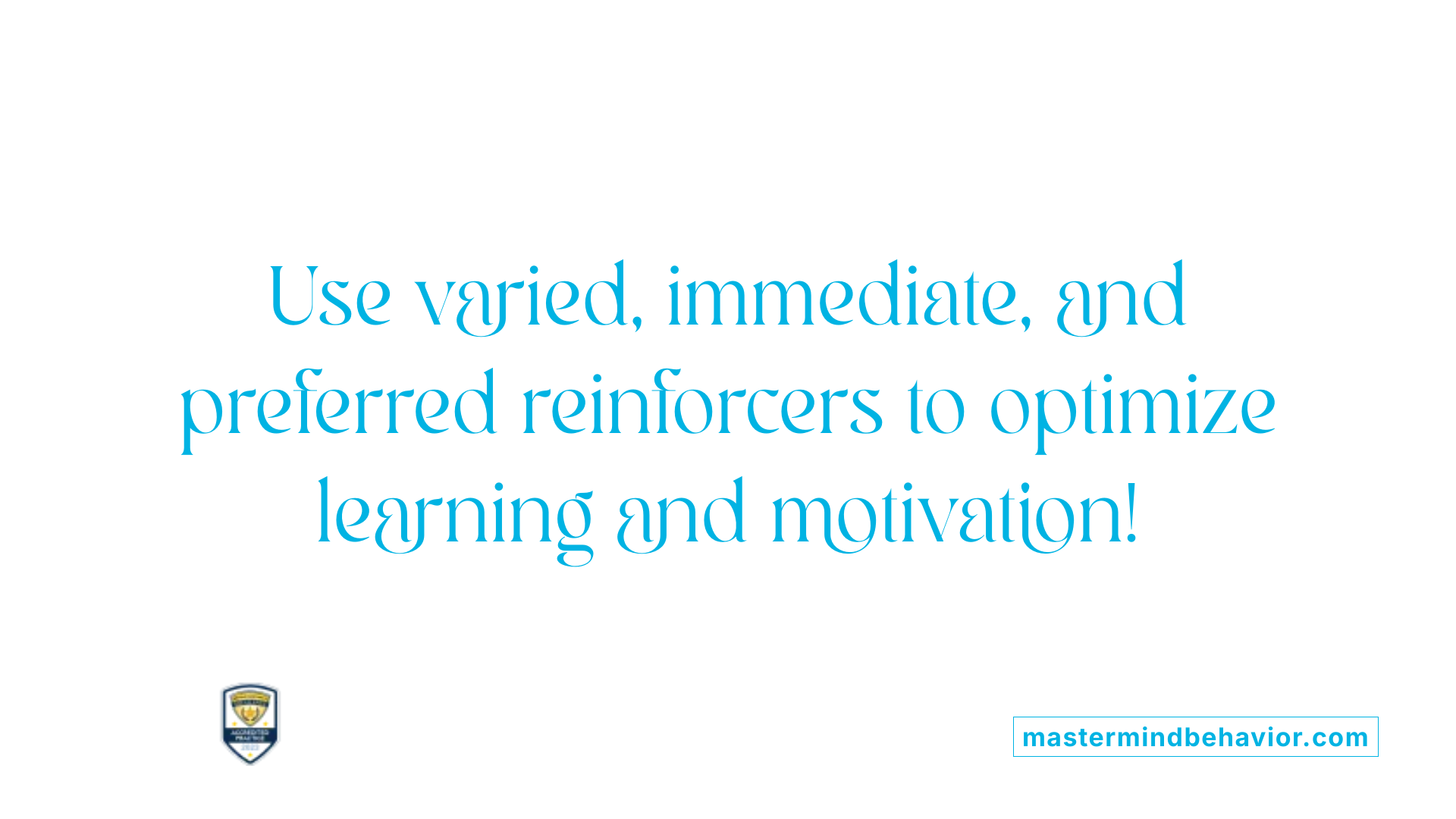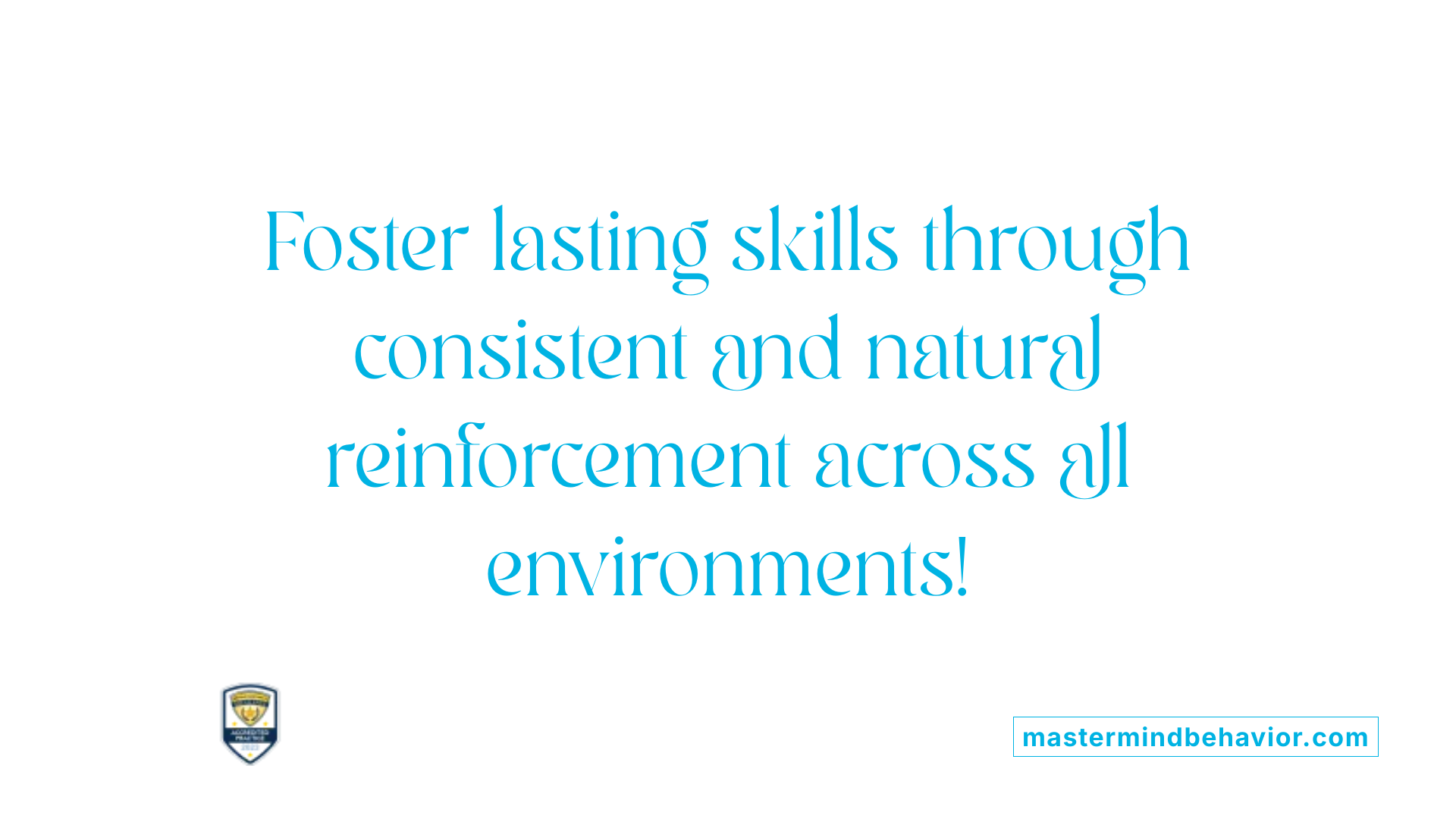How Reinforcement Works in ABA Therapy: Best Practices

Understanding the Power of Reinforcement in ABA
Reinforcement is a cornerstone of Applied Behavior Analysis (ABA), a scientifically supported approach for teaching new skills and reducing problematic behaviors, particularly in children with autism. By carefully selecting and applying reinforcement techniques, therapists can shape, maintain, and generalize meaningful behaviors that enhance quality of life. This article explores how reinforcement works within ABA therapy, emphasizing best practices and fundamental principles to optimize outcomes.
The Core Role of Reinforcement in ABA Therapy

What is the role of reinforcement in ABA therapy?
Reinforcement is a cornerstone of Applied Behavior Analysis (ABA) therapy. Its main purpose is to influence behavior by providing consequences that increase the chances of a behavior happening again.
In ABA, reinforcement involves attaching a positive outcome to a specific behavior. This could mean giving a reward after a child completes a task or removing an unpleasant stimulus if the child performs a desired action. When these consequences are connected to behaviors, individuals are more likely to repeat those behaviors in the future.
Reinforcement strategies are not one-size-fits-all. They are carefully selected based on what motivates each individual. The reinforcement is delivered immediately after the behavior, helping the person understand the link between their action and the positive result. This immediate feedback is vital for effective learning.
Therapists use various forms of reinforcement—such as social praise, tokens, preferred toys, or sensory stimuli—to motivate clients. Regular use of reinforcement supports the learning of new skills, reduces unwanted behaviors, and encourages behavior generalization across different environments like home or school.
Ultimately, reinforcement shapes, maintains, and broadens socially important behaviors, making it an essential element in the success of ABA therapy.
How Reinforcement Functions in Behavior Analysis
 Reinforcement is fundamental to the practice of behavior analysis, serving as the primary method for shaping and modifying behavior. It is rooted in the principles of operant conditioning, established by B.F. Skinner, which posits that consequences influence the likelihood of a behavior occurring again.
Reinforcement is fundamental to the practice of behavior analysis, serving as the primary method for shaping and modifying behavior. It is rooted in the principles of operant conditioning, established by B.F. Skinner, which posits that consequences influence the likelihood of a behavior occurring again.
In ABA, reinforcement works by controlling consequences to either increase or decrease specific behaviors. When a behavior is followed by a positive outcome or reward, its future occurrence becomes more likely—a process known as positive reinforcement. Conversely, removing an unpleasant stimulus (negative reinforcement) after a behavior can also increase the chances of that behavior happening again.
Behavior shaping through consequences involves various reinforcement strategies. For example, differential reinforcement techniques—like DRA (Differential Reinforcement of Alternative Behavior), DRI (Differential Reinforcement of Incompatible Behavior), DRO (Differential Reinforcement of Other Behavior), and DRL (Differential Reinforcement of Low Rates)—are employed to reinforce selected appropriate responses while reducing maladaptive ones.
A crucial aspect of effective reinforcement is its contingency. Contingent reinforcement depends directly on the occurrence of specific behaviors, ensuring that responses are linked to rewards. Non-contingent reinforcement, however, happens randomly and is less effective for behavior modification.
To sustain and enhance behavior change, ABA therapists utilize reinforcement schedules, which specify how often and under what conditions reinforcement is given. These schedules include fixed or variable ratios and intervals, creating predictable or variable reinforcement patterns that influence behavior maintenance.
In addition to schedules, reinforcement protocols are tailored to individual needs. Maintaining motivation involves selecting reinforcers that the person values, such as praise, tokens, toys, or activities. Consistent, immediate reinforcement strengthens learning, while regular updates and rotations of reinforcers prevent satiation and keep the individual engaged.
Overall, reinforcement plays a vital role in teaching new skills, reducing problematic behaviors, and supporting generalization across different settings. When correctly applied, it promotes positive developmental outcomes and long-term behavioral improvements in children with autism and other learning needs.
| Reinforcement Type | Example | Function | Additional Notes |
|---|---|---|---|
| Positive | Giving praise after a task | Increases behavior | Adds a desirable stimulus |
| Negative | Removing stress after completing a task | Increases behavior | Removes an aversive stimulus |
| Primary | Food, water | Naturally motivating | Essential for survival |
| Secondary | Tokens, praise | Learned motivators | Can be exchanged for rewards |
| Schedule-based | Fixed ratio, variable interval | Sustains behavior over time | Maintains motivation |
| Differential | DRA, DRI, DRO, DRL | Reinforces specific behaviors | Targets behavior shape |
By systematically applying these reinforcement strategies, ABA therapy effectively encourages desirable behavior change and skill acquisition, making it a cornerstone of behavioral interventions.
Fundamental Principles of Reinforcement in Behavior Analysis
How do behaviors’ likelihood to recur change with reinforcement?
In behavior analysis, reinforcement is used to increase the chances that a specific behavior will occur again in the future. When a behavior is followed by a reinforcing consequence—such as praise, a reward, or a pleasant outcome—the individual is more likely to repeat that behavior. This process is grounded in the idea that consequences shape future responses, making reinforcement a powerful tool for encouraging desired behaviors.
What are the different types of reinforcement, and how do they work?
Reinforcement can be classified into two main types: positive and negative. Positive reinforcement involves presenting a preferred stimulus after a behavior, like giving a child a toy or praise when they share. Negative reinforcement, on the other hand, involves removing an unpleasant stimulus—such as letting a child leave a stressful situation once they complete a task—to increase the likelihood of the behavior happening again.
Which characteristics affect the effectiveness of reinforcement?
Several factors influence how well reinforcement works. Immediate delivery of reinforcement is crucial, as it helps the individual link the behavior with the consequence. The reinforcement should also be contingent on the behavior, meaning it occurs only if the behavior is performed. Additionally, the reinforcer must be preferred or motivating for the individual, which requires assessing personal preferences. The size of the reinforcement and whether the individual is deprived of it can also impact its effectiveness.
What are the different kinds of reinforcers?
Reinforcers can be broadly categorized into social, object, and sensory types. Social reinforcers include attention, praise, or hugs, which are especially effective for children. Object reinforcers involve tangible items like treats, toys, or stickers. Sensory reinforcers provide stimulating input, such as tactile or visual experiences, that increase the likelihood of behavior recurrence.
Why are immediacy, contingency, and preference important?
Providing reinforcement immediately after a behavior ensures the individual makes a clear connection between the action and the consequence. Contingency means the reinforcement is dependent on the specific behavior, which helps reinforce the correct response. Recognizing and incorporating individual preferences—whether a toy, praise, or activity—maximizes motivation and the effectiveness of reinforcement.
| Aspect | Description | Examples |
|---|---|---|
| Behavior recurrence | Likelihood of behavior repeating after reinforcement | Child saying “please” more often after praise |
| Types of reinforcement | Categories based on the stimulus or removal involved | Positive (toy), Negative (removal of stress) |
| Effectiveness factors | Conditions influencing reinforcement success | Immediate, contingent, preferred stimuli |
| Reinforcer varieties | Types of stimuli used as reinforcers | Social, object, sensory |
| Timing & preference | Critical components for reinforcement success | Immediate delivery, personal choice |
Applying these principles thoughtfully ensures that reinforcement effectively promotes learning and positive behavioral changes, especially in ABA therapy contexts such as supporting children with autism.
Best Practices for Implementing Reinforcement in ABA
What are the best practices for implementing reinforcement in ABA therapy?
Effective reinforcement is a cornerstone of successful ABA therapy. One of the first steps is selecting reinforcers that are genuinely meaningful to the individual. This can involve conducting preference assessments to identify items or activities the person finds motivating, such as favorite toys, praise, or activities.
Using a variety of reinforcers helps prevent satiation—a situation where the individual becomes less responsive because they are receiving the same reward repeatedly. Alternating reinforcers keeps motivation high and encourages continued engagement.
Timing is critical. Reinforcement should be delivered immediately after the behavior occurs. This immediacy helps the individual associate the behavior with the positive outcome, making learning more effective.
Consistency across different environments, such as home, school, and therapy sessions, ensures that skills are generalized and maintained. Reinforcement should be applied reliably to reinforce desired behaviors across all settings.
Incorporating tools like reinforcement schedules—such as continuous or intermittent reinforcement—can help shape learning and maintain behaviors. Preference assessments can be repeated regularly to update reinforcers based on changing interests.
Descriptive praise combined with tangible or preferred items enhances the reinforcement’s impact. Regular monitoring allows therapists to evaluate which reinforcers are effective and adjust strategies accordingly.
Finally, avoiding reinforcement of undesirable behaviors and focusing on reinforcing positive, functional behaviors promotes a more adaptive learning process. This strategic approach helps foster motivation and long-term skill development within ABA therapy.
Application of Reinforcement Techniques in ABA

How are reinforcement concepts applied in ABA therapy?
In Applied Behavior Analysis (ABA), reinforcement forms the foundation of behavior change. Practitioners systematically select specific stimuli that are most motivating for each individual, ensuring that these stimuli effectively increase the likelihood of desirable behaviors. This tailored approach involves daily assessment of preferences, which can include tangible items like toys or treats, or social rewards such as praise and attention.
Therapists use both positive and negative reinforcement strategies. Positive reinforcement involves adding a desirable stimulus immediately after a target behavior, like giving praise or a preferred reward to encourage repetition. Negative reinforcement, on the other hand, involves removing an unpleasant stimulus—for example, allowing a child to leave a stressful situation after they perform a desired task—to increase the occurrence of that behavior.
Contingent, immediate reinforcement is crucial in ABA, as it helps the individual connect their behavior with the positive outcome. Therapists often employ differential reinforcement techniques, which focus on reinforcing specific appropriate behaviors while withholding reinforcement for maladaptive or undesired responses. This can include strategies like DRA (Differential Reinforcement of Alternative behavior) or DRO (Differential Reinforcement of Other behavior), which help shape skills and reduce problem behaviors.
Monitoring progress is integral to effective reinforcement planning. Regular data collection allows therapists to evaluate if the chosen reinforcers are effective or if adjustments are needed. Rotating or updating reinforcers prevents satiation and maintains motivation, ensuring continued engagement.
By tailoring reinforcement strategies to individual needs and preferences, ABA practitioners foster the acquisition of new skills, promote social interactions, and support adaptive behaviors. This personalized approach ensures that reinforcement remains effective over time, facilitating long-term behavior change and enhancing overall learning outcomes.
Effective Strategies for Reinforcement in ABA Practice

How can reinforcement strategies be tailored to individual needs?
In ABA therapy, personalizing reinforcers is crucial for motivating each child. Effective reinforcement involves selecting items or activities the child finds enjoyable — such as favorite toys, praise, or special privileges. This focus on individual preferences makes the reinforcement meaningful and more likely to influence behavior positively.
What is the role of reinforcement schedules?
Using reinforcement schedules, like fixed or variable intervals, helps maintain consistent behavior over time. These schedules determine how often reinforcement is given, promoting sustained engagement. For example, initially reinforcing every correct response can lead to more consistent behavior, then gradually shifting to less frequent reinforcement helps generalize skills across settings.
Why is immediate and consistent reinforcement important?
Delivering reinforcement immediately after the behavior helps the child connect the action with the reward, strengthening learning. Consistency is key; applying reinforcement reliably across different environments, whether at home or in the community, reinforces the behavior and supports generalization.
How do you monitor and adjust reinforcement strategies?
Regularly observing how a child responds to reinforcement allows therapists to fine-tune their approach. If a reinforcer loses appeal, switching to a new one prevents satiation. Tracking progress ensures that reinforcement remains aligned with the child's evolving interests and motivates continued growth.
What variety of reinforcers can be used?
A range of reinforcers—primary (like food and water), secondary (such as tokens or praise), and activity-based rewards—can be used in ABA. Using different types keeps learning engaging and prevents boredom, leading to better skill acquisition and behavior maintenance.
| Reinforcer Type | Examples | Purpose |
|---|---|---|
| Primary Reinforcers | Food, water | Meets basic needs, highly motivating |
| Secondary Reinforcers | Tokens, praise, stickers | Can be exchanged or paired with primary reinforcers |
| Activity Reinforcers | Extra playtime, preferred tasks | Encourages engagement in functional activities |
| Social Reinforcers | Hugs, smiling, verbal praise | Facilitate social skill development |
Applying these strategies systematically helps promote positive behaviors and supports meaningful learning outcomes in children receiving ABA therapy.
Promoting Generalization and Long-Term Learning
 Reinforcement plays a vital role in ensuring that learned behaviors are not only acquired but also maintained across various settings and over time.
Reinforcement plays a vital role in ensuring that learned behaviors are not only acquired but also maintained across various settings and over time.
Reinforcement across different environments is crucial. Applying consistent reinforcement in multiple settings—such as at home, school, and community—helps individuals connect learned behaviors with a variety of situations. This consistency encourages the transfer of skills from one context to another, making behaviors more functional and adaptable.
Using natural reinforcement involves rewards that naturally occur in daily life. For example, a child who finishes a task and then receives social praise or experiences tangible benefits like playing with a favorite toy naturally reinforces the behavior. This approach helps learners associate behaviors with outcomes that are meaningful in real-world scenarios, promoting sustainable behavior change.
Maintaining motivation over time is supported by rotating reinforcers. Regularly introducing new or varied rewards prevents satiation—where the individual becomes bored or less interested in previously used reinforcers—keeping them motivated to continue behaviors. Adjusting reinforcement schedules and types of rewards ensures sustained engagement and progress.
To effectively foster generalization and long-term learning, reinforcement strategies should be seamlessly integrated into everyday routines. When reinforcement is embedded within natural activities and varied appropriately, individuals are more likely to carry skills beyond structured therapy sessions, maintaining behaviors long-term.
| Concept | Description | Example |
|---|---|---|
| Reinforcement in multiple settings | Applying consistent reinforcement across various environments | Praising a child for polite behavior at home and in the community |
| Natural reinforcement | Rewards that occur naturally in life | Verbal praise after completing a task |
| Rotating reinforcers | Changing rewards to prevent satiation | Using different toys or praise types over time |
| Motivation maintenance | Sustaining interest in behaviors | Introducing new activities or reinforcement methods |
By systematically using reinforcement in everyday situations, adapting rewards, and ensuring behaviors are meaningfully connected to real-world outcomes, individuals are more likely to generalize skills and retain them over the long term.
Harnessing Reinforcement for Lasting Impact in ABA
Reinforcement is a powerful and nuanced tool within ABA therapy that, when applied correctly, can radically transform behaviors and facilitate meaningful learning. Effective reinforcement hinges on understanding individual preferences, delivering consequences immediately and consistently, and adapting strategies based on ongoing assessment. By integrating best practices—such as using varied reinforcers, promoting natural reinforcement, and ensuring reinforcement across diverse environments—therapists and caregivers can support the development of durable, socially significant skills. Ultimately, mastery of reinforcement principles not only accelerates learning but also fosters independence, motivation, and lifelong success.
References
- Understanding Reinforcement in ABA: Key Principles and ...
- Reinforcement Strategies: What is this Cornerstone of ...
- Understanding Reinforcement in ABA Therapy
- Reinforcement: What it is & Why it's Important to ABA
- 10 Common ABA Therapy Techniques
- Understanding Reinforcement in ABA: Key Principles and ...
- Principles of Reinforcement & How They Work in ABA
- What is Differential Reinforcement? Exploring its Applications
Recent articles

How to Navigate Autism Laws and Legal Support Services In NJ And GA
Comprehensive Legal Frameworks Supporting Autism Therapy in NJ and GA

How ABA Therapy Improves Adaptation To New School Environments
Supporting Children with Autism Transitioning into School through ABA Therapy

Strategies For Building Peer Relationships Through ABA Social Skills Training
Building Meaningful Peer Connections with ABA-Based Social Skills Training

How ABA Therapy Improves Communication With Teachers And Peers
Empowering Social Connections: The Role of ABA Therapy in Autism

How ABA Therapy Encourages Teamwork And Cooperation Skills
Unlocking Social Success: The Role of ABA Therapy in Fostering Teamwork and Cooperation

Teaching Coping Skills For Test Anxiety Through ABA Therapy
Harnessing ABA Therapy to Equip Children with Autism Against Test Anxiety



